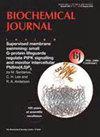酵母非编码rna的功能分析和转录谱分析。
IF 4.3
3区 生物学
Q2 BIOCHEMISTRY & MOLECULAR BIOLOGY
引用次数: 0
摘要
先进的转录组学技术已经鉴定出大量的非编码rna (ncRNAs),它们普遍存在于酵母基因组中。ncrna可分为短ncrna (200 nt)。这些转录物通过转录和降解机制受到严格调控,以维持适当的细胞稳态并防止异常表达。研究表明,ncrna可以在各种调控过程中发挥作用,特别是在转录调控中。虽然短的ncrna被很好地表征,但lncrna的功能仍然知之甚少。功能和转录谱分析已被应用于填补lncRNA功能领域的空白。功能分析证明,这些长转录本在基因调控、RNA代谢、性别分化和端粒悬垂稳态等方面发挥着重要的细胞作用。此外,转录谱分析允许表征参与细胞周期、集落亚群动力学、毒力和调控网络的ncrna。本文主要介绍了酵母ncrna的分类、细胞命运、进化与保护、作用机制和结构分析。本文章由计算机程序翻译,如有差异,请以英文原文为准。
Functional analysis and transcriptional profiling of non-coding RNAs in yeast.
Advanced transcriptomic technology has identified a great number of non-coding RNAs (ncRNAs) that are pervasively transcribed in the yeast genome. ncRNAs can be classified into short ncRNAs (<200 nt) and long ncRNAs (lncRNAs; >200 nt). Those transcripts are strictly regulated through transcription and degradation mechanisms to maintain proper cellular homeostasis and prevent aberrant expression. It has been revealed that ncRNAs can play roles in various regulatory processes, particularly in transcriptional regulation. While short ncRNAs are well characterised, the function of lncRNAs remains poorly understood. Both functional and transcriptional profiling have been applied to fill the gap in the lncRNA functions landscape. It has been proven by functional profiling that these long transcripts can serve important cellular roles in gene regulation, RNA metabolism, sexual differentiation and telomeric overhang homeostasis. In addition, transcriptional profiling allowed the characterisation of ncRNAs involved in the cell cycle, colony subpopulation dynamics, virulence and regulatory networks. In this review, we introduce the classification, the cellular fate, the evolution and conservation, the mechanisms of action, and the profiling of yeast ncRNAs.
求助全文
通过发布文献求助,成功后即可免费获取论文全文。
去求助
来源期刊

Biochemical Journal
生物-生化与分子生物学
CiteScore
8.00
自引率
0.00%
发文量
255
审稿时长
1 months
期刊介绍:
Exploring the molecular mechanisms that underpin key biological processes, the Biochemical Journal is a leading bioscience journal publishing high-impact scientific research papers and reviews on the latest advances and new mechanistic concepts in the fields of biochemistry, cellular biosciences and molecular biology.
The Journal and its Editorial Board are committed to publishing work that provides a significant advance to current understanding or mechanistic insights; studies that go beyond observational work using in vitro and/or in vivo approaches are welcomed.
Painless publishing:
All papers undergo a rigorous peer review process; however, the Editorial Board is committed to ensuring that, if revisions are recommended, extra experiments not necessary to the paper will not be asked for.
Areas covered in the journal include:
Cell biology
Chemical biology
Energy processes
Gene expression and regulation
Mechanisms of disease
Metabolism
Molecular structure and function
Plant biology
Signalling
 求助内容:
求助内容: 应助结果提醒方式:
应助结果提醒方式:


